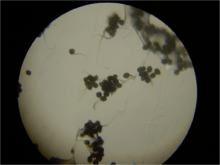Ulocladium
Ulocladium is a genus of fungi. Species of this genus contain both plant pathogens and food spoilage agents. Other species contain enzymes that are biological control agents. Some members of the genus can invade homes and are a sign of moisture because the mold requires water to thrive. They can cause plant diseases or hay fever and more serious infections in immuno-suppressed individuals.
| Ulocladium | |
|---|---|
 | |
| Ulocladium sp. conidiophores | |
| Scientific classification | |
| Kingdom: | |
| Division: | |
| Class: | |
| Subclass: | |
| Order: | |
| Family: | |
| Genus: | Ulocladium Preuss (1851) |
| Type species | |
| Ulocladium botrytis Preuss (1851) | |
Species of Ulocladium resemble those of genus Alternaria with which they were once included. Several DNA-based phylogenetic studies place Ulocladium convincingly within Alternaria, suggesting that the latter is the correct classification for these species.[1] However, Ulocladium, unlike Alternaria, do not produce alternariols, tenuazonic acid, altersolanols, or macrosporin.
The species Ulocladium oudemansii is utilised as a biocontrol agent against Botrytis cinerea. The New Zealand company Botryzen (2010) Ltd uses it to control Botrytis bunch rot in the NZ vineyard industry
Species (approximately 20)
- Ulocladium alternariae (Cooke) Simmons, fungal agent of pistachio
- Ulocladium atrum, biocontrol of Botrytis cinerea
- Ulocladium botrytis Preuss, claimed not a pathogen, but found to cause onychomycosis
- Ulocladium chartarum (G Preuss) EG Simmons, disease in immuno-suppressed patients
- Ulocladium chlamydosporum
- Ulocladium consortiale, plant pathogen of caraway
- Ulocladium cucurbitae (Letendre & Roum.) EG Simmons, leaf spot pathogen of cucumber
- Ulocladium dauci EG Simmons
- Ulocladium lanuginosum(Harz) EG Simmons
- Ulocladium litoreum Pivkin & Zvereva
- Ulocladium manihoticola JM Yen
- Ulocladium manihoticolum JM Yen
- Ulocladium microspora Moub & Abdel-Hafez
- Ulocladium multiforme EG Simmons
- Ulocladium oblongo-ovoideum XG Zhang & TY Zhang
- Ulocladium ovoideum EG Simmons
- Ulocladium oudemansii EG Simmons, biocontrol of Botrytis cinerea
- Ulocladium populi E.G. Simmons, G. Newcombe & A. Shipunov
- Ulocladium septosporum (Preuss) EG Simmons
- Ulocladium tuberculatum EG Simmons
References
- Woudenberg, JHC; Groenewald, JZ; Binder, M; Crous, PW. (2013). "Alternaria redefined". Studies in Mycology. 75 (1): 171–212. doi:10.3114/sim0015. PMC 3713888. PMID 24014900.
- Ulocladium species
- Ulocladium pathogenicity
- Ulocladium species
- www.botryzen.co.nz] Botryzen (2010) Ltd
- Woudenberg, JHC; Groenewald, JZ; Binder, M; Crous, PW. (2013). "Alternaria redefined". Studies in Mycology. 75 (1): 171–212. doi:10.3114/sim0015. PMC 3713888. PMID 24014900.